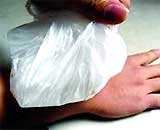Cold compress for injury
When sprains, joints, bruises ., do not forget to chill. This therapy helps relieve pain and edema by increasing the stimulus threshold of muscle fibers, causing vasoconstriction, reducing the amount of blood circulation in the affected area.
 In daily work, play, exercise and sports, people can get into accidents that cause various injuries such as sprains, joints, muscle bruises, fractures, electrocution, burns. For emergency on-site, there are basic techniques such as bandages, hemostasis, fixation, transportation and artificial respiration . depending on the injury situation. However, in many cases, people forget to use cold therapy.
In daily work, play, exercise and sports, people can get into accidents that cause various injuries such as sprains, joints, muscle bruises, fractures, electrocution, burns. For emergency on-site, there are basic techniques such as bandages, hemostasis, fixation, transportation and artificial respiration . depending on the injury situation. However, in many cases, people forget to use cold therapy.
With some common injuries such as sprains, muscle bruises, muscle tears, moderate and mild ligament tear, it is possible to conduct self-treatment at home, cold compressing is especially effective. When these injuries occur, depending on the degree of injury, in the first 24-72 hours, the lesion area should be completely quiet to implement measures such as cold compressing, fixing and improving posture. lesion area.
Cold compressions on the trauma area are used as an independent method, in the process of treating common injuries in general and sports injuries in particular. This method is simple but effective but it is extremely big. Cold compressions increase the stimulating threshold of muscle fibers, constrict vasoconstriction, reduce blood flow in the affected area, leading to reduced edema and pain relief. Cold compressions reduce muscle spasms leading to improved circulation and result in decreased metabolic disorders in the injured area.
In order to achieve the highest efficiency, cold compressing should be done right in the first minutes after an injury. In the first 48-72 hours, cold compressing should be done regularly. Each cold spell lasts 15-20 minutes, the interval between two episodes is about 120-180 minutes (in the first 24 hours it should be done more often, the interval between two episodes is about 30-60 minutes). Depending on the degree of injury, cold compressing can be carried out until the 7th day after injury with decreasing frequency.
With minor injuries, edema and low blood flow, just applying cold compresses for the first 24 to 48 hours is enough. The duration of each cold period of about 10-15 minutes depends on the type of injury and the depth of the injury.
Cold compressing techniques are as follows: Use small ice or unburnt ice wrapped in plastic or damp cotton towels (ice temperature is about 0-3 degrees C). Cold compresses should apply a layer of neutral cream, Vaselin . to avoid the risk of cold damage. Gently apply the ice block to the surface of the trauma area, gently massage the concentric circle for 5-10 minutes depending on the anatomical characteristics of the lesion area.
The characteristic feeling when using this method is that the area is felt cold, painful and finally the feeling of numbness.
Avoid painful movements, as pain can cause spasms. The lesion area must be maximally relaxed to facilitate recovery
At this stage, cold compressions are combined with the following measures:
Squeeze bandage : Use a bandage or squeeze the bandage to press the injury area tight enough to reduce edema and create firm support for the injured joint area. The bandage for injury during the cold compressing procedure by dressing over the ice block, and the bandage during the period between two cold packs.
Maintain posture: The lesion area should be kept in an elevated position to avoid blood stasis and limit edema development. Depending on the injury department, we have a suitable high hanging posture to prevent obstruction to activities. If conditions permit, it is advisable to raise the injury area above the head.
Things to pay attention to
In the first 72 hours after an injury, do not use any method or substance (including bathing with hot water), cause hot areas, not use high, do not massage the injury, do not drink alcohol. All these will increase edema and bleeding in the injured area.
This self-treatment regimen is only used at the initial stage of initial treatment or emergency. Depending on the nature and extent of the injury, you can see a doctor as soon as possible. Need to see a doctor if within 24-48 hours of using self-treatment measures on symptoms of muscle, tendons, joints, ligaments (pain, edema) are not relieved, or more pain, edema more masonry.
While using this self-treatment regimen, it is possible to use anti-inflammatory analgesics (aspirin, ibuprofen .) depending on the injury.
Dr. Dang Quoc Bao
- Technology for early detection of brain injury in children
- Why play volleyball prone to finger blue?
- The influence of cold weather on the goalkeeper
- Chinese breakthrough treatment of spinal cord injury
- How to manage and prevent eye injury in children
- Exercise to prevent injury
- Real story 'soul changes after head injury'
- Vinegar helps detect cervical cancer
- Northern region is cold, there is a cold place in the right Christmas Eve
- 7 ways to prevent headaches without taking medicine
- Minor head injury is also dangerous
- Accumulation of cold Lady Ban
 Green tea cleans teeth better than mouthwash?
Green tea cleans teeth better than mouthwash? Death kiss: This is why you should not let anyone kiss your baby's lips
Death kiss: This is why you should not let anyone kiss your baby's lips What is salmonellosis?
What is salmonellosis? Caution should be exercised when using aloe vera through eating and drinking
Caution should be exercised when using aloe vera through eating and drinking